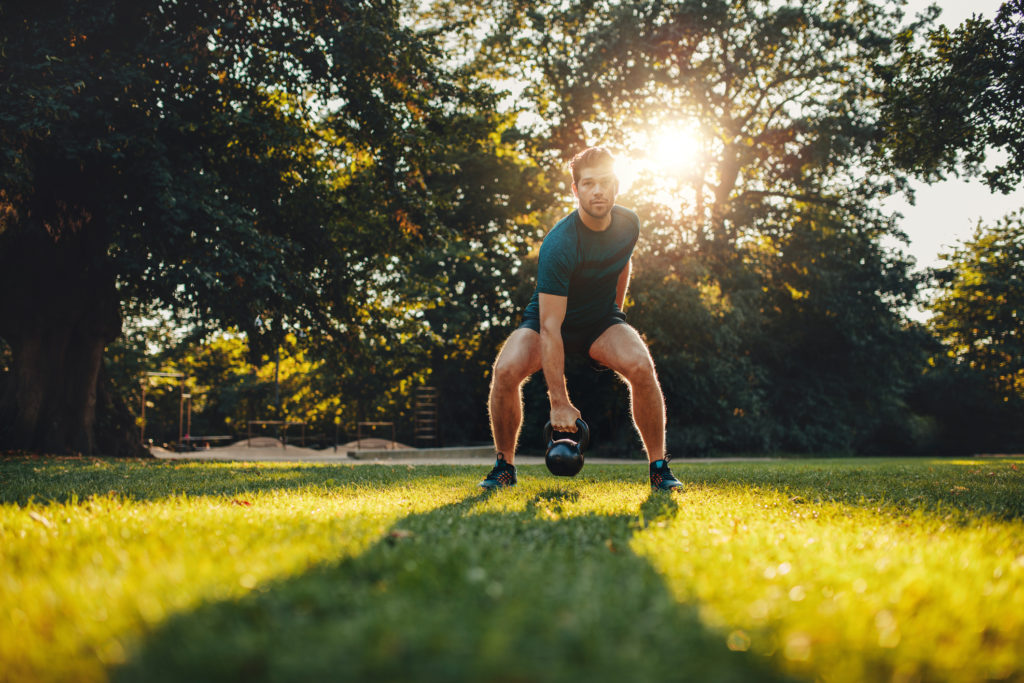Without a mobile, stable and strong hip girdle we lose performance in the big rocks of both acceleration and deceleration: namely the glute and hamstring groups. To gain and maintain a fully functioning set of hips, consistent workouts are key, which is why the program below is designed to be completed with minimal equipment and in any setting, whether it’s the gym or a hotel room. All you’ll need is a dumbbell, a kettlebell and a little floor space.
Warm-up
Starting position: Adopt a standing split stance with your left leg forward and your right foot as far back as you can. Be sure to keep your heels planted to the floor throughout the exercise. Perform 30 seconds of each movement then switch your feet in the split stance to work your left hip.
- Hip Flexion and Extension
Tuck your pelvis forwards and back while reaching your arms overhead to cause extension through the right hip. To create hip flexion step your left leg behind you as far as you can while keeping your heel on the floor, and reach both arms in the same direction. This will give your right hamstring a good stretch while flexing your hip, as well as a little dorsiflexion and plantar flexion in the feet. - Hip Adduction and Abduction
Back in the initial split stance position drive your hips to the left and reach your arms up and to the right, then repeat on the other side. This will result in adduction and abduction of the hips (and shoulders), as well as lateral flexion in the core. - Hip Internal and External Rotation
In the starting stance lead your pelvis in rotation to the left and right with your arms at chest-level following the direction of your hips. Be careful not to rotate further than your hips will allow.
Workout
Select an appropriately weighted kettlebell and dumbbell for these dynamic movements. The weight of the load is less important than the quality of the movement, so don’t go too heavy. A guide weight might be a 14kg k ettlebell and a 10-12kg dumbbell, but choose weights that work for you. Stick to an endurance-based number of repetitions (15+) for a three set minimum.
- Multidirectional Lunges: (Video demonstration)
Mix up your lunge pattern by imagining a clock on the floor with you stood in the middle. Lunge with your right leg to every point on the clock, starting at 12 o’clock, and working your way around clockwise. Be sure to keep the toes of your left foot facing midnight/midday. This will work your hips (and foot/ankle/knee) in flexion, extension, abduction, adduction, internal and external rotation.
- Kettlebell Swing and Step: (Video demonstration)
A traditional swing with the added dynamic element of a step will test your control in gait. Place the kettlebell on the floor about an arms length in front of you, so you have to reach for it before you get swinging. Drop your hips and allow the kettlebell to swing just between your legs but no further; this will protect your lower back. Push the glutes forward, snap your hips and as the weight comes to chest height take a step forward ensuring that both feet are back to parallel before the kettlebell comes back towards the earth.(The swing is driven by that all important posterior chain with alternate steps adding a tricky motor control/gait type element. Only perform the step when you are comfortable with the swing. To progress the exercise feel free to add in a turn after a few reps or step backwards.)
- Kettlebell/ Dumbbell Snatch and Step: (Video demonstration)
Take the weight with one hand in a half squat stance, drop your hips and push the weight overhead as you explode upward. Add the alternating forward step when the weight is returning back toward your hips to test the posterior. A kettlebell will require much more control so a dumbbell is a good substitute but will dampen your need to decelerate.
- Dumbbell Split Jerk: (Video demonstration)
Plyometric training is important to include to work on power as well as landing. Start from a slight squat and perform an overhead shoulder press with the dumbbells. Just before you reach the top of the movement do a small jump, landing in a split stand or lunge position. It’s all about the speed of getting into the finishing foot position rather than the height of the leap. Keep the weight light as an excessive load will put a huge strain on your core, particularly the lower back.
The whole session can act as a focused workout on the hip or as part of a larger training protocol. Ideally these exercises should be filtered into your existing programme in order to compliment the work already being done. Remember to always move within your means and through a range of motion, speed and angulations in which you feel comfortable i.e. if you lose stability or are restricted by your mobility or strength then strip it back and simplify the exercise. Don’t be afraid to start without the load of the kettlebell or dumbbell, use these as progressions. With a mobile, stable and strong set of hips you’ll be better equipped to fall with control.
Workout courtesy of Technogym master trainer David Howatson
technogym.com







